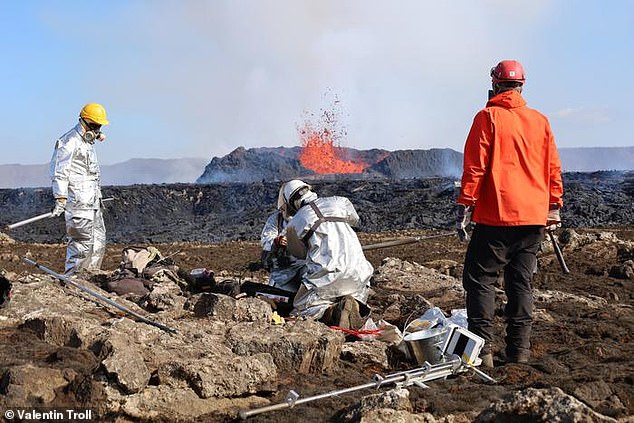
ICELAND'S VOLCANO ERUPTION ON THE REYKJANES PENINSULA MAY LAST DECADES
- The eruptions of the previous three years are all fed by a single magma reservoir
- Researchers warn that the peninsula could be entering a new volcanic period
- READ MORE: Scientists reveal how bad Iceland's volcanic eruption could get
Since 2021, Iceland has been rocked by eight volcanic eruptions that have sent citizens fleeing from their homes.
But experts now warn that the worst may be yet to come for the residents of the Reykjanes Peninsula.
To see why the area had suddenly become so active, an international team of scientists studied lava samples and seismic data from the last three years of eruptions.
They discovered that the peninsula is sat on an interconnected magma plumbing system that could keep volcanoes fed with molten rock for decades to come.
Lead author Valentin Troll, professor of petrology at Uppsala University, says: 'A comparison of these eruptions with historical events provides strong evidence that Iceland will have to prepare and be ready for this volcanic episode to continue for some time, possibly even years to decades.'
Iceland is located directly above something called the Mid-Atlantic Ridge, a boundary between the tectonic plates of Eurasia and North America.
As these plates drift apart, hot rock from Earth's mantle, the largest of the planet's layers, can squeeze its way up to the surface.
This makes volcanic eruptions a fairly common part of life, with one occurring about once every three to five years.
However, after remaining dormant for 800 years the islands Reykjanes Peninsula suddenly became active again in 2021 during the Fagradalsfjall Fires.
In late 2023 and early 2024 new volcanic fissures formed near the fishing town of Grindavik, pumping huge plumes of lava out onto the surface.
The resulting eruptions have led to the evacuation of the town, destroyed three houses, and repeatedly closed the Blue Lagoon - one of the country's most popular tourist destinations.
To understand why this area has suddenly been hit by such intense volcanic activity, scientists attempted to find out where the lava for these eruptions was coming from.
Just like every person has a unique fingerprint, every piece of magma has a unique combination of about 50 different trace elements and three different isotypes of oxygen.
Professor Ilya Bindeman, a volcanologist from the University of Oregon, explains: 'In the air we breathe, there's a mixture of these oxygen isotopes and we don't feel the difference.
'Their differences are usually not important for chemical reactions but are important to recognize as their relative abundances in magma can differentiate one magma source from another.'
By sampling the lava from different eruptions over the last three years, researchers realised that they all had an extremely similar chemical fingerprint.
Professor Troll told the MailOnline: 'Geochemical analysis of major and trace elements as well as stable isotopes imply that the magma erupting at Svartsengi since late 2023 is of the same type as the magmas that erupted at Fagradalsfjall between 2021 and 2023.
'Therefore the two eruption sites are fed from the same magmatic source at depth.'
Combining this insight with local earthquake data, the researchers suggest that the Reykjanes Peninsula sits atop a magma reservoir about 5.5 to 7.5 miles (9-12km) down in the earth’s crust.
Since that reservoir is likely being fed by a melting rock deep in the mantle, there is more than enough magma to keep hundreds of square miles of lava flowing at the surface for decades, the experts claim.
The prospect is more worrying given that the last volcanic era in the peninsula lasted for centuries, with eruptions being common between 800 and 1240 CE.
Professor Troll says: 'The area experiences more intense episodes of tectonic plate motion with durations of 100 to 200 years followed by lower activity intervals of some 700 to 900 years.
'It appears we are at the very beginning of such a renewed episode of more intense tectonic activity.'
In the 800 years of volcanic dormancy the Reykjanes Peninsula has become one of Iceland's most important regions.
The southwestern region is home to 70 per cent of the country's population, its only international airport, and several geothermal power plants.
Residents got a sense of how bad things could be earlier this year when lava flows came dangerously close to the Svartsengi Geothermal Power Plant.
Professor Troll says: 'Based on prior eruptive behaviour, this pattern is likely to continue into the future, posing considerable risk to the local population and to important infrastructure.'
She notes that this includes: 'Keflavík Airport, several geothermal power plants, the Blue Lagoon tourist spa, and population centres like Keflavík, Grindavík, and Greater Reykjavik.'
The discovery of the shared magma reservoir could make risk could be even higher as it suggests there will likely be several simultaneous eruptions along the peninsula.
The researchers are warning that Iceland and the Reykjanes Peninsula will likely need to brace for more volcanic activity in the future.
Although it is extremely difficult to predict exactly when a volcano will erupt, the researchers now say that more eruptions are likely.
Co-author Frances Deegan, Researcher at Uppsala University, says: 'Our findings provide valuable information for anticipating and managing future volcanic activity on the Reykjavik Peninsula.
'We would like to stress the need for preparedness.
Read more 2024-06-26T10:26:43Z dg43tfdfdgfd
